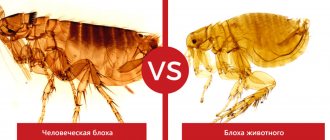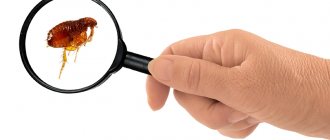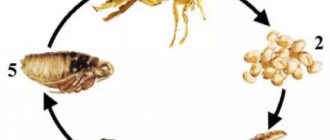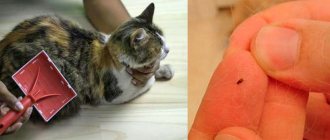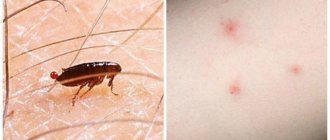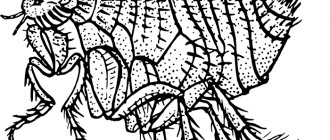The infestation of cats by fleas in cities and towns in Russia is usually seasonal and by the end of summer and autumn, up to 70% of cats are affected by this ectoparasite.
In nature, there are more than 100 species of fleas that infect our domestic animals, and some of them can attack humans.
Ctenocephalides felis (cat flea) is mainly found in cats. Simultaneously with cat fleas, cats can be attacked by fleas from dogs and rodents.
Morphology and development cycle.
Fleas are wingless insects. They have a bilaterally flattened body, covered with numerous spines and bristles, thanks to which fleas are held between the hairs of the cat's fur. The flea has six legs, the two back ones are more developed, thanks to which the flea has the ability to move in the cat’s hair at any angle and make long jumps, up to 1.5 meters. On the flea's abdomen there are special tactile hairs that are very sensitive to any air fluctuations. The chitinous cover protects the flea from any mechanical damage. Adults are brown in color, the size of the female is 2-2.3 mm, the size of the male is 2-2.5 mm. The mouthparts are piercing-sucking, simple eyes, epipharynx and antennae are located on the chitinous head. Adult fleas feed on the cat's blood. Sometimes they can feed on the blood of other animals. Blood enters the flea's stomach. Which has a volume of about 0.5µl, while at the same time, when sucking cat blood, the stomach can accommodate a blood volume 10-20 times larger. The flea's stomach is able to digest a small amount of blood consumed; most of the blood is released by the flea into the cat's hair in the form of small black feces. It has been noted that the flea has the ability to starve for several months. Upon external examination of flea-infested fur, we find a large amount of these feces, which look like poppy seeds.
The flea is an insect with a full development cycle. It has the stages of adult insect, egg, imago and pupa. The female flea lays her eggs wherever necessary, due to the absence of a sticky mass on its surface, from which after about 2 weeks a worm-like larva appears, which begins to grow, molting several times. Indoors, the larvae live in dust and debris, feeding on decaying organic matter and excrement. Later, the larva pupates and after some time an adult insect emerges from the pupa. The insect's lifespan is approximately 2 years. Parasites reproduce very actively; during her life, a female flea can lay up to 2 thousand eggs.
Pathogenesis. When fleas come into contact with a cat, they bite through the epidermis and begin to suck blood from the bitten capillaries. As a result of a massive flea infestation, a cat may develop multiple bites on its skin within a few minutes. The cat develops an allergic reaction to antigens that are present in the flea’s saliva and are introduced into the cat’s skin through bites, and allergic dermatitis appears. As a result of a flea bite with its infected blood, feline infectious anemia (hemobartonellosis), in which red blood cells are damaged, can be transmitted to a cat through a damaged membrane. It has been established that fleas contribute to the infection of cats with invasive diseases. In particularly sensitive cats, prolonged itching can develop even with a small number of fleas parasitizing the cat. As a result of constant itching, papules, scabs and bald patches appear on the cat's skin.
Clinical picture. A cat affected by fleas is accompanied by the presence of severely itchy areas on the body, and the cat not only constantly itches, but bites into the bite site with its teeth. As a result of constant scratching, the hair falls out in certain areas of the body (the neck area is most often affected), and the combed skin becomes covered with reddish crusts. Constant itching makes the cat nervous. During a clinical examination, the veterinarian finds flat miniature dots attached to the skin in the hair, similar in appearance to millet grains. Having drunk blood, fleas begin to move actively, and in some cases, jump. Using a magnifying glass, you can notice a dark brown, flat, elongated body measuring 2 or 3 mm, no wings, and long, jumping hind legs. In the depths of the fur near the skin, upon careful examination, a specialist finds waste products of fleas - dark-colored, fine-grained excrement. At the same time, upon careful examination, you can find flea eggs, which, unlike excrement, are oval in shape, larger and white in color.
In cats, as a result of flea infestation, complications often occur in the form of pyotraumatic dermatitis. With severe flea infestation, anemia is recorded as a result of a decrease in the amount of blood. Sometimes we note symptoms of lymphadenopathy and eosinophilia.
Unlike lice and lice eaters (which are parasitic bloodsuckers), fleas have great jumping ability when viewed, jumping up to a height of half a meter, and can move along the cat’s body, covering as much as 30 cm in one jump. While the louse crawls over its victim.
The diagnosis of a cat being affected by fleas is made based on the collected history, clinical picture of the disease, season and, of course, on the basis of the detection of fleas or flea feces. When making a diagnosis, you can resort to thorough combing of the fur with a thick comb. Place the particles combed out of the hair onto moistened filter paper. After a few minutes, a red zone appears around the combed out grains - representing flea feces with excess blood. The presence of a red zone is considered to be a diagnostic sign of a cat being affected by fleas, even if no living fleas are found. The disease is accompanied by the presence of eosinophilia in the cat.
Differential diagnosis. When conducting a differential diagnosis, veterinary specialists must exclude the presence of other ectoparasites (ticks, lice), dermatophytoses (ringworm, etc.), folliculitis, dietary disorders (lack of biotin, essential fatty acids), and food allergies in the cat.
Fleas in cats: morphology and development cycle
The cat flea is one of the parasites of animals that can also attack humans. She looks like a tiny dark insect without wings. Body size: 0.5–5 millimeters. However, a female engorged with blood can swell up to 16 millimeters.
Fleas parasitize cats and rats. When attacking a person, it selects the area of the legs below the knee.
The lifespan of a flea depends on living conditions and usually ranges from 3 months to 1.5 years.
Favorable conditions for fleas
| Temperature | 20–25 ºС |
| Air humidity | 60 % |
| Humidity | 70 % |
Fleas breed all year round. One female is capable of laying from 2 to 15 eggs at a time. Thus, an individual can reproduce about 500 throughout its life.
Important! This number is arbitrary, since for the eggs to fully mature, the female needs to fully feed on blood.
Places for laying can be different: cracks in the floor or walls, bedspreads or animal beds, food waste, soil, pet hair.
Stages of flea development:
- Egg. A tiny white dot. Size: 0.5 millimeters. Cycle: from 2 days to 2 weeks.
- Larva. Resembles a worm with segmented hairs. Size: about 5 millimeters. It is mobile, growing by eating feces, blood or plant waste. Cycle: from 9 days to 8 months.
- Doll. Looks like a larva in a cocoon. Cycle: from 6 days to 1 year.
- Imago. Is a full-fledged adult.
Types of fleas that live on pets
There are several types of blood-sucking parasites that live on animals, humans, and rodents. Each of these species is adapted to a certain body temperature, blood and other characteristics of its “host”. However, if there is no one nearby, then the flea can be content with those warm-blooded animals or people who are nearby. What kind of blood-sucking parasites live on pets?
The cat flea (Ctenocephalides felis) is one of the most common species among the flea order. Their color varies from red to dark brown. On an animal, these insects look like particles of dirt, and only when they move can you understand that they are fleas. Insect eggs look like white grains. Sometimes black flea excrement that remains on the animal's fur and skin is mistaken for eggs. The female insect does not lay eggs on the animal. Favorite places for masonry are cracks in floors, upholstery of upholstered furniture, carpets and rugs. The body of a cat flea is covered with spines and bristles, thanks to which it quickly moves through the animal's fur. The hind legs are well developed for jumping, while the front legs are slightly shorter and are designed for moving along wool. The body is flat with a small head and a voluminous abdomen.
Why are cat fleas dangerous to humans? Because it is from them that people suffer the most. These parasites bite dogs, cats, and people. If they feed on the blood of an infected animal, they also absorb pathogens. With the next bite, the insect transmits the causative agent of the disease to a new host. Cat fleas are transmitted to humans three times more often than dog fleas.
On dogs
(Ctenocephalides canis) - dog flea. These bloodsuckers choose warm-blooded animals as their victims. Therefore, dogs, cats, and horses are ideal for them. Can dog fleas live on humans? No, but they will not refuse human blood in times of famine either. Parasites have a flat body, flattened on the sides, covered with many bristles and ridges of flat teeth. They are perfectly adapted to life in populated areas and are able to live without food for 2 months. But cat fleas, suction fleas, and human fleas can also live on dogs.
Are fleas transmitted from dogs to humans? Their gnawing-sucking mouthparts are adapted only to survive on dogs, but if the insect is starving, it is capable of biting cats and humans. The length of a dog flea's jump is 4 times the length of its vision, that is, it does not see where it is jumping. Animal fleas are very well adapted to living in their fur. They have a body length from 1 to 5 mm. The color of the insects varies from straw to brown. They have a body flattened on the sides with hairs and bristles that help them stick to the fur of their host. Are dog fleas scary for people? Nothing good can be expected from such “guests”. These blood-sucking parasites hibernate under poor conditions and can survive without food for several months. As soon as favorable conditions arise, the insect wakes up and begins to jump on people and animals, constantly feeding on the blood of its victim. They can constantly change their “master”, transmitting various infections from sick animals to people.
How do fleas appear on a cat?
The appearance of fleas in cats can be caused by a number of reasons:
- The animal loves to explore the entrances and basements of the house. After all, rooms without ventilation with the same level of humidity and a minimum of light are ideal conditions for the reproduction of fleas.
- Penetration of insects from neighboring apartments. Fleas can move through the thinnest cracks, so there is only one way to protect yourself from uninvited guests after getting rid of them - to make high-quality repairs.
- Contact with an infected cat – even minimal animal contact is enough.
- Carrying fleas on clothes. Unfortunately, the owner can infect the animal on his own, and in this case it is impossible to protect himself from undesirable consequences.
- Inadequate cleaning after treatment of the cat. Simply washing the floors and bowls is not enough: eggs or larvae may remain in furniture, carpets or the animal's bed. If fleas appear in the house again, repeated treatment and better cleaning of the premises is required.
Ways to control fleas
The best way to get rid of flea bites and prevent their occurrence is prevention.
Simultaneously with treatment, insect extermination operations must be carried out. The entire house needs to be cleaned and sanitized. This is quite difficult, but prevention is better than subsequent treatment. After all, itching from a flea bite, swelling and redness are the mildest symptoms that may appear. The most effective method of killing insects is treating premises with chemicals. The most effective agents are chlorpyrifos, cypermethrin and others. Before processing, it is necessary to remove all sources of heat, since the preparations are highly flammable, close all food products and remove pets from the premises, because insecticides are very toxic.
After treatment, any remaining drug should be removed. Insecticide chemicals do not reach hidden areas (such as behind furniture) or affect pets, so these products must be used in combination with other methods for maximum effect.
Contact specialists who will carry out high-quality disinfection of the premises. Only professionals will be able to finally rid the room of harmful insects by treating the room with specialized means.
How dangerous are fleas on a cat?
In cats, fleas can cause both minor health problems and very serious problems. In the first case, the animal is bothered by itching, so it begins to actively scratch: wounds and abrasions appear.
If the owner rids the cat of fleas immediately, there will not be much damage to health. However, in advanced cases, dermatitis may develop. In addition, cats tend to bite and swallow fleas, which is dangerous due to intoxication, helminth infection and even anemia.
Flea allergic dermatitis
Dermatitis in cats is provoked by flea bites and subsequent active scratching. Animals that are prone to allergies are at risk.
Flea saliva consists of complex compounds that are not dangerous in small doses. But if a cat is repeatedly bitten, it may develop hypersensitivity.
Signs of flea dermatitis:
- itching;
- redness;
- scratches, open wounds;
- hair loss.
The disease progresses quickly, so it is important to start treatment as soon as possible. You can also deal with fleas at home. The main thing is an integrated approach.
Important! Flea dermatitis is dangerous due to complications that will inevitably arise in the presence of open wounds. After all, they are a natural environment for bacteria. If an unpleasant odor begins to emanate from the animal, this is a sure sign that the wound has a yeast or bacterial infection.
Anemia in kittens
Anemia is a pathology in which there is a simultaneous drop in the level of red blood cells and hemoglobin in the blood. It can develop in an adult animal. However, it is most dangerous for a kitten’s fragile body due to the likelihood of death.
Anemia can be caused by various reasons. One of them is flea infestation.
Signs of anemia in a kitten:
- weakness;
- pallor/cyanotic/yellowishness of the mucous membrane;
- refusal to eat;
- weight loss;
- dyspnea.
Anemia is a serious disease. It cannot be cured by simply getting rid of the original source, which is cat fleas. Therapy includes taking various medications that are aimed at restoring normal blood composition. And only a veterinarian can prescribe them.
Infectious and parasitic danger of fleas: hemobartonellosis and dipilidia
Hemobartonellosis is an infectious anemia. It is provoked by microorganisms carried by fleas and mosquitoes. Unlike classical anemia, a malfunction of the body occurs due to the fact that microbes directly destroy red blood cells.
The disease is dangerous because it occurs secretly. Symptoms may not appear for up to 5 months after infection.
Signs of hemobartonellosis:
- decreased activity;
- loss of appetite;
- weight loss;
- pallor of the mucous membrane;
- heat;
- enlarged spleen.
Important! Hemobartonellosis requires complex treatment, which may include blood transfusions. And even if the cat recovers, liver or kidney failure may persist.
Dipilidiosis is a disease caused by the cucumber tapeworm. The parasite is white-gray or pink in color. It can reach 70 cm in length and 3 mm in width. A cat can become infected with dipilidia by eating adult fleas - they are the carriers of the pathogen larvae.
Signs of infection:
- weight loss;
- changes in eating behavior;
- The cat is constantly nervous.
Important! Dipylidiasis is also dangerous for humans.
Treatment and prevention
You realized that your cat has fleas, and now you are thinking about how to get rid of them. We have already said that the procedure for exterminating parasites is not limited to disinfestation of the pet. However, first of all, you need to decide exactly what to remove fleas from your cat. All other events are carried out later, unless, of course, one of the two-legged inhabitants of the house became the victim of the bite. You can get rid of cat fleas using the following scheme:
- Destroy all pests using shampoo, drops or spray (we will tell you more about these means later).
- After a few days, additionally treat the cat for fleas by washing it with regular shampoo and thoroughly combing it with a comb.
- Force the victim to take a course of vitamins and other restorative medications to normalize the coat and skin. After removing fleas from a cat, treatment with hormonal ointments and ozone (prescribed by a veterinarian) may also be required. This therapy has a positive effect on inflammation and itching.
- Take preventive measures to prevent the problem from happening again (put on a collar or regularly treat with the necessary medications).
There are many things that can help with fleas in cats, but the best way to do this is to consult a qualified veterinarian. An animal can have an allergic reaction to almost any product, so it is better to entrust the process to a specialist. At least when it comes to taking restorative medications. Before washing your cat for fleas, read the instructions carefully. Any of your “amateur activities” can end in failure.
We told you how to deal with fleas on a cat. Now, the room should be treated so as not to give the parasites the slightest chance of a new “annexation”. It is better to call professionals who have solid experience in exterminating small pests. You can get rid of fleas from your cat and clean your apartment yourself. This is not the most sophisticated procedure, but in this case you assume all the risks associated with the incorrect use of chemically hazardous substances. You will also need to re-treat the rooms to destroy eggs and larvae that hatched after disinfestation.
If you suspect that your neighbors “helped” you to complete the educational program on the topic of what cat fleas look like, try to establish contact with them. If they are adequate people who are able to recognize the problem, prevention will become even more effective. To remove fleas from a cat at home, it is also recommended to thoroughly treat all objects with which the cat comes into contact. In addition to the bedding, this can be a carrying basket and the interior of the car.
Symptoms of flea infestation
It is difficult to detect fleas at the initial stage. However, this is quite possible if you examine the cat’s stomach. It is in this area that, upon careful examination, insects or their feces can be seen.
Signs of flea infestation:
- active scratching;
- the cat is worried, reacts sharply to stimuli, meows;
- loss of appetite;
- weakness, reluctance to play.
If you do not get rid of fleas on a cat in time, the animal will begin to lose weight, and ulcers will begin to form at the bite sites. In addition, advanced infestation is associated with the presence of bald spots in the fur.
Lice and lice eaters
These arthropods can be safely combined into one group, because they are “terribly similar,” although they belong to different orders. Lice are most often Felicola subrostratus, lice eaters are Mallophaga.
What do lice and lice look like?
- The body, just like a flea’s, is flat, up to 2-3 mm long. Color – light beige or transparent white.
- The head is wider than the chest, flat, quadrangular.
- The eyes are poorly developed.
- The abdomen is also wider than the chest and longer than the chest and head combined!
- The oral apparatus is not adapted to pierce the skin and suck out blood, and, despite the fact that it is considered gnawing, neither the louse nor the lice eater are capable of inflicting wounds on the owner.
These creatures are capable of gnawing only with the upper part of the mouth opening, which is used to “saw off” the wide lower end of the hair or dead parts of the epidermis, which curl upward when dry. This leads to ringworm-type baldness and frequent dandruff.
And also - nits. These are lice and lice eggs.
How do lice reproduce on a cat?
They are specific in relation to the owner, because they spend their entire life on his body, because have incomplete transformation - they will never grow long, strong legs that can help them jump up to 1 m in height, like a flea. Simply put, the louse and the lice eater are “unfinished” fleas.
The females of these “unfinished” eggs lay up to 100 eggs, which are attached to the root part of the hair with special glue - uterine secretion. The whitish tiny balls visible at the root of the hair are nits of specific permanent entomoses.
After 7-12 days (it all depends on the species and environmental conditions), these nits hatch into larvae that are similar in appearance to the adult. Over the next 12-20 days, the larva molts 3 times and turns into a sexually mature individual, which immediately begins its life activity - firmly clings with its paws and claws to the root of the hair and begins to gnaw it and drink blood.
Diagnostics: how to determine that a cat has fleas?
Before you start fighting fleas, you need to make sure that it is they that are bothering your cat:
- It is necessary to pay attention to where exactly the cat is itching. Fleas are active on the sides and back (or on the whole body if the infestation is advanced), and ticks are active behind the ears and in the groin.
- Flea eggs and feces in a cat. If white and black dots are observed on the skin and at the base of the hair, it means that there are adult fleas on the animal.
- Skin irritation. Ulcers, scratches, and redness are typical signs of an advanced flea infestation.
- Detection of fleas by visual inspection. It’s easy to understand that it’s a flea in front of you. It has a rounded body 0.5 millimeters long and very thin long legs. You can find insects if you simply move the fur in different directions. In addition, fleas will begin to jump off the cat while bathing - no other insect can do this.
Features of cat fleas
The flea that can be found on a cat is the closest relative of rat and dog fleas. But despite this, its appearance is quite specific. Although the subtle differences between flea species are only accessible to specialists, it is useful to know the appearance of cat fleas. These parasites can transmit many dangerous diseases by biting a person.
It is mainly this type of flea that attacks cats, other animals and people in both rural and urban areas. While other types of fleas “remain faithful” to one “master”. Interestingly, if cat fleas settle on a rat, they will soon completely displace these same insects, which parasitize only on rodents.
There are no anesthetic enzymes in the saliva of a cat flea, so its bite is very painful.
What do pests look like?
The flea that parasitizes cats looks like an extremely small insect of a dark brown, almost black color. She can literally appear for a second in the animal’s fur and hide there again. The size of the parasite's body directly depends on its age and can range from 0.8 to 4 mm, the average length is 2–3 mm.
This type of insect is devoid of wings, but its powerful hind legs more than compensate for their absence - they allow it to disappear from sight with lightning speed, jumping to a height of 30 cm in any direction. The body of the parasite is flattened on the sides, which gives it the following advantages:
- It's hard to crush a flea
- it is convenient for her to move in her owner’s fur,
- During the jump, air resistance is almost not noticeable.
Video: cat flea under a microscope
It is worth noting that cat fleas and lice belonging to different types of insects can annoy cats. Moreover, it is almost impossible to meet them on one representative of the cat family. The louse lives in the fur constantly, but the flea only jumps on your furry pet while feeding. And lice cannot change their source of food, while a flea does this easily and with pleasure.
The dimensions of a cat flea are smaller than those of a rat or dog flea. In addition, in a rat parasite, the end of the body is slightly raised, while in a dog parasite, the head is larger. True, it is very difficult to notice all these differences by eye, because the parasites sit in one place only during the bite, and their small size interferes with a thorough study of the flea.
Photo gallery: different types of fleas
The cat flea parasitizes not only “its” animal, but also other mammals
The human flea most often lives near where a person sleeps
Rat fleas are carriers of many deadly infections
The dog flea's body is covered with bristles, and its legs have hooks that help it stay on the dog while moving.
How to tell if your cat has fleas
At the very beginning of the appearance of fleas, they may be invisible to the eye, but already at this time signs appear that should alert the owner. So, the cat begins to twitch sharply and immediately itch, while literally biting into the fur and skin. Under the fur you can see scratches from scratching. The following experiment will help identify the presence of parasites:
- The cat is placed on a white sheet of paper.
- They begin to comb the animal.
- If small black-brown pellets appear on the white surface, this is flea excrement. To further check, drop water on them - they will take on a brownish-red hue.
Observing them live will help you to finally make sure that your pet has parasites. To do this, move the cat's fur with a fine comb in several places and you will be able to see the moving flea or its feces, which look like black dust or sand.
The cat flea development cycle involves eggs, larvae and pupae being laid and developing outside the animal's fur, so only adult fleas bother the cat
During the process of breeding, female parasites do not lay eggs, but literally shoot them as far as possible in different directions. This gives more larvae a chance of survival if conditions are unfavorable.
What to do if your cat has fleas: treatment methods and review of remedies
You can remove fleas from a cat using different means. They come in different forms:
- drops;
- shampoos;
- sprays;
- collars;
- pills.
In addition to common sprays, shampoos, and tablets, there are even ultrasonic repellers that hang as a keychain on an animal’s collar. However, not all of them are effective.
Most flea remedies have a prolonged action, that is, the effect lasts for a long time (1-6 months).
Before you start removing fleas, it is important to consider a number of points:
- age of the cat;
- whether the pet is sick (a weakened animal cannot be treated with chemicals);
- tendency to allergies to the components of the drug.
For kittens, pregnant and lactating cats, you will need to buy specialized products.
Fleas on a cat - drops
As a rule, drops require a single use. Depending on their composition, they have a destructive or repellent effect. Products containing insecticides are the most effective, but they must be used strictly according to the instructions (the dosage is calculated based on the weight of the cat). Drops with essential oils are not so toxic, so they are suitable for weakened animals, but in case of advanced infestation they will not be able to help.
List of effective drops:
- Advantage.
- Leopard.
- Advocate.
- Frontline Combo.
- Stronghold.
The advantages of drops include speed (fleas die in 1–2 days), as well as versatility (many drugs simultaneously fight lice, lice and ticks). Disadvantages - the need to prevent the cat from coming into contact with water and small children. In addition, many drops are not suitable for newborn kittens or pregnant or lactating cats.
Important! As a rule, the drops are valid for 3 months. After this period, the animal will need to be processed again.
Fleas on a cat - shampoos
Shampoos kill fleas if you wash your cat once, but do not have a delayed effect. Like drops, depending on the composition, they either repel fleas or destroy them.
List of effective shampoos:
- Outpost.
- Beaphar.
- Mr. Bruno.
- Mr. Kiss.
- Rolf Club.
The advantage of shampoos is that they can be used not only for their intended purpose, but also to wash rugs from beds or wash toys. They are suitable for kittens and pregnant and lactating cats, as long as they do not contain insecticides.
Disadvantages of shampoos: the fragility of the effect and the risk of poisoning the animal if the product is not thoroughly washed off the fur.
Sprays
Using a spray you can remove not only fleas, but also their larvae and eggs. In addition, products of this kind are effective against lice, ticks and lice-eaters.
When choosing a drug, it is worth considering that they come in 2 types:
- for processing animals;
- for processing the room.
List of effective sprays:
- Leopard.
- Celandine.
- Frontline.
- Hartz.
- FitoDoc AB3.
Sprays can kill fleas in a single application, even with an advanced infestation. However, this effectiveness is explained by strong toxicity - if used incorrectly, they can harm the animal and provoke allergies. Although there are drugs that are suitable for 2-day-old kittens, for example Frontline.
Important! Sprays are used strictly according to the instructions. It is not enough to simply treat the animal in a ventilated area. You need to put on your work clothes and then wash them thoroughly. You should also make sure that the drug does not get into your pet’s eyes.
Collars
Collars are also used to kill fleas or repel them. In the first case, the tape is impregnated with insecticides, in the second - with vegetable and essential oils. These points should be taken into account if the animal is still small or is bearing offspring.
Adult cats and kittens over 3 months of age can wear insecticide collars. For kittens, pregnant and lactating cats - with esters.
List of effective tapes:
- Leopard.
- Doctor Zoo.
- Celandine.
- Beaphar.
- Hartz.
Collars last a long time - up to 6 months. There are also models with complex action: against fleas, lice, ticks and lice at the same time. They are not as toxic as sprays, but are not able to cope with insects if the infestation has reached a critical stage. In this case, it is better to apply drops or spray, and then apply tape to the already treated cat.
The key to the effectiveness of the collar is proper wearing. The tape should not fit tightly. A finger should fit freely between the collar and the animal's neck. It is also important to cut off any excess tape that remains after the fastener is attached. The cat may bite it, which will cause poisoning.
Interesting! Manufacturers have long moved away from the monotonous production of black collars. Nowadays you can find ribbons in a variety of colors on the shelves. Now, in addition to protection against fleas, there is also an aesthetic point: you can choose a collar that matches the color of a particular cat.
Pills
Tablets stand apart among flea control products. This is a last resort when the animal is in a neglected state. External preparations are not suitable if the cat has dermatitis and other skin lesions. It is in such cases that it is necessary to resort to tablets.
However, treatment at home cannot be done without consulting a specialist. It should be understood that an animal with a serious infestation requires the help of a veterinarian. The list of drugs in tablet form is quite wide.
There are products for one-time use, and there are those that are taken in a course. There are drugs only against fleas, and there are drugs against fleas and ticks at the same time. Therefore, only a veterinarian can choose the right remedy after examining the animal.
List of known tablets:
- Comfortis.
- Bravekta.
- NexGard.
Important! Manufacturers produce dog flea tablets. They should not be given to cats, even if we are talking about drugs for small breed dogs. Many medications that are intended for canines depress the cat's nervous system.
What do you need to know?
Each parasite lives on average three months, but some varieties can live up to two years (taking into account all stages of development). Those of them that live in Russian latitudes are able to fall into a numb state when unfavorable conditions occur and return to activity if necessary. In the absence of living organisms for a long time, they are able to wait a long time, clinging to the skin as soon as the opportunity arises. Most common questions:
- Where do fleas come from in humans? In most cases, they get into the house by catching on the paws of a passing dog or cat or on the legs of the person himself. Most types of domestic fleas live on pets, since human temperatures are not comfortable for them, but they also bite people;
- Why do fleas appear? The desire for blood is their natural need, so to avoid problems, you should follow simple hygiene rules and regularly treat your pets with protective drugs;
- Where do fleas start? In the wild, they live in tall grasses, bushes and other similar places, and cling to the first warm-blooded animals they come across. If left untreated, insects multiply in the fur of domestic animals; if the population expands, the carpet, underground, sheets, and furniture become infected.
That's why it's better to prevent your home from getting infested with these parasites than to deal with it later. Anti-flea collars, flea drops and other similar means of protection will help protect your pet, and at the same time your home, from the penetration of unpleasant blood-sucking insects. Protective measures will make it possible to avoid other threats that these creatures carry within themselves.
Home disinfection
After treating a cat, an important step in the fight against fleas is treating the home.
Professional disinfection
Professional disinfection is the most effective. A team of specialists will arrive at your home, assess the sanitary condition of the home and choose the most appropriate disinfection method. Typically, disinfection is carried out either using a heat gun or using chemicals. The owner is only required to prepare the house and pay for the services.
Important! A few days after professional treatment, you may find fleas on the floor. However, do not think that the service was provided poorly. Insects could easily remain in the cracks and gaps, but upon contact with the treated surface they quickly die. A similar phenomenon can be observed within 5 weeks after the visit of specialists.
Disinfect yourself
You can disinfect your home yourself using a spray or powder.
Processing stages:
- Remove children, animals and indoor plants from the house.
- To throw out the trash.
- Move furniture away from the walls. Remove from the walls all objects that hang on them.
- Put on work clothes.
- Spray the entire home, including carpets, upholstered furniture, clothing, shoes and bedding. Particular attention should be paid to the animal's belongings.
- Close doors and windows. Leave the house for several hours, ideally all night.
- Upon return, ventilate the rooms well, wash all surfaces and wash all items that have been processed.
Unlike sprays, powders are less effective, but when using them you do not need to leave your home. It is enough to scatter the granules in places where fleas are most concentrated (cracks, areas behind the baseboard). Upon contact with the granular substance, not only adult individuals die, but also their larvae and eggs.
Are these parasites transmitted to other animals or people?
Cat fleas, unlike other types of these parasites, are quite unpretentious in food, and they can be called lovers of warm-blooded mammals, and not just cats. Therefore, bloodsuckers from a cat can easily jump to a dog or person. Features of the lifestyle do not at all imply that parasites must live permanently on the host. Their larvae do not need blood at all to develop.
Humans can also become victims of cat fleas. To do this, it is enough to be near a cat infected with parasites or even near its litter. In addition, bloodsuckers can attack you:
- near an enclosure where other animals live;
- in a neglected apartment;
- in the entrance, where homeless animals are rarely cleaned and often spend the night;
- on farms, mainly rabbit ones;
- in places where rodents are common - in a field, meadow, near a hayloft or granary;
- in the forest near the habitat of wild animals: badger, fox, etc.
Small black grains in the animal's fur (flea feces) mean that your cat is being attacked by blood-sucking parasites
How to remove fleas from a cat at home using folk remedies: myths and reality
Myth #1: Wormwood repels fleas. This is certainly true. You can pick up several armfuls and place them in different corners of the house. There will be fewer fleas, but the effect will only last until the plant dries out. In addition, the smell of wormwood is specific even to humans. So there is a risk of not only fleas leaving the house, but also guests and household members.
Myth No. 2: Essential oils will save you from fleas. Peppermint, pine, eucalyptus and lavender are safe for cats. As a rule, you can find advice on the Internet that says that you need to dilute a few drops in a glass of water and treat the animal with the resulting solution. Next, the oil concentrate is dripped onto sponges or napkins, which are laid out in different places in the house. However, it is worth considering here that essential oils do not kill insects, but only repel them. So there can be no talk of complete deliverance. In addition, odors disappear quickly: the animal will need to be treated daily, as will the napkins.
Myth #3: Let there be salt and soda. The saline or soda solution is safe for kittens and pregnant and lactating cats. It is prepared like this: 100 grams of the substance are diluted in 1 liter of warm water. It is used according to the following scheme: the animal must be kept in the resulting solution for 10–15 minutes, after which it is washed with baby soap, dried and combed. You can also wash the floors in your apartment with this solution and wash your pet’s bed. However, there are controversial points here too. You can’t keep the whole animal in the solution: the head will still be above the water, which means insects may well run across it. Washing a room with salt is associated with stains, so washing and re-washing is still necessary afterwards. And such solutions are effective only for 3-4 days, and then require repeated use.
Which method of fighting fleas deserves attention is determined by everyone for themselves. However, it is worth understanding that traditional methods either simply repel insects or act for an extremely short time. Therefore, you can resort to them only if the animal is allergic and categorically cannot tolerate the effects of chemicals. However, after this, it is advisable to temporarily transfer the pet to friends and disinfect the home with chemicals.
Prevention measures
What to do if insects appear in the house? Do cat fleas bite humans? We found out that yes, which means that animals should be checked for parasites. We must not forget about household items. Jumping insects are able to hide in clothes, carpets, fleecy fabrics, plush toys, etc. All clothing must be washed and steamed. The room is treated with the latest generation insecticides, for example, “Raid” or “Combat”
Subsequently, it is important to carry out regular wet cleaning, vacuum upholstered furniture, shake out rugs
It is better to entrust the disinfection of the premises to qualified specialists. We are ready to help solve this problem if you contact us by phone or send a request by email. After sanitization of the premises, long-term ventilation is carried out. It is good if two weeks after the main treatment it is possible to carry out repeated disinfection.
People usually pay attention to flooring and furniture located in the lower part of the room. But the trouble is that fleas can jump high, hiding in curtains, wall hangings and other interior items
If fleas bite your legs, what should you do? On the street you can protect yourself from parasites using repellents. It is enough to treat your clothes with flea spray, and reliable protection is guaranteed. It is recommended to wear closed clothing when outdoors that fits tightly around the wrists and ankles, preventing the penetration of insects. Repellents can also help at home. “For me, this is a reliable way to protect myself from insects,” says one of the owners of a large family of cats. “I monitor the health of my charges, but when the conversation turns to parasites, it’s better to be safe.”
Harm to a person
The main impetus for the study of fleas was the fact that they are capable of transmitting the plague.
In modern conditions, the reason that forces us to consider this problem with special attention is the inconvenience caused by fleas to people and pets. This can even lead to a real illness (read more about whether fleas are dangerous for humans and what diseases they carry here)
It is also frightening that fleas are sometimes intermediate carriers of certain types of worms that can seriously disrupt the functioning of certain human organs and lead to the loss of a significant amount of useful substances. Probably no one will be happy to hear that fleas carry deadly infections.
Sometimes there are so many fleas in a room inhabited by domestic animals that people are simply unable to withstand their invasion. This fact can have a strong impact on the nervous system of the home owners. In addition, there may be a reaction that appears on the skin.
Very often the bite site becomes inflamed and swelling forms. The cause of the itching and unpleasant sensation is the flea saliva injected under the skin during the bite. You won’t envy those people whose flea bites cause terrible allergies. It is not for nothing that scientists have invented a special antigen to overcome its consequences.
Find out what to do with bites in children and how to relieve itching?
There are cases when a fertilized female settles under the skin of the owner. An example is the sand flea, which often causes wounds and ulcers to fester on the body.
Sticky fleas are not limited to single manifestations, but are prone to forming entire colonies on the heads of birds or cats' ears.
Another dangerous parasite, the pumpkin tapeworm, uses the flea as an intermediate host and, given the opportunity, may well move into the human body and lead to the development of helminthiasis.
An equally dangerous disease that fleas can spread is endemic typhus, the potential victims of which are residents of port cities.
Interestingly, adult fleas infected with a certain infection do not pass it on to their offspring, but they themselves are capable of remaining carriers of dangerous diseases throughout their lives.
Danger of ectoparasites
In addition to the serious discomfort that blood-sucking insects living in its fur cause a cat, fleas pose a great danger. They are carriers of a huge number of dangerous diseases. Some of them can be fatal. A number of diseases carried by fleas are dangerous not only for animals, but also for humans.
Fleas carry:
- the causative agent of yersiniosis - an acute intestinal infection accompanied by a toxic-allergic reaction;
- bacteria that cause Far Eastern scarlet fever (pseudotuberculosis);
- plague stick;
- causative agent of hemorrhagic septicemia (pasteurellosis);
- bacteria that cause intestinal infection salmonellosis;
- Brucella;
- bacteria that cause tularemia;
- rickettsia;
- hepatitis viruses type B and C, tick-borne encephalitis;
- Trypanosomes are protozoan parasites that cause a number of diseases in humans and animals.
In addition, fleas are carriers of helminth eggs. If a cat has a lot of fleas and has been infected with them for a long time, then there is no doubt that she has endoparasites (for example, cucumber tapeworms).
The presence of fleas in a pet leads to a decrease in its immunity and causes various allergic reactions. Also, the appearance of ectoparasites leads to an exacerbation of chronic diseases, if the cat has any. Due to severe itching, the animal constantly scratches its skin, sores and wounds form on the body. They can fester, which will seriously complicate the pet’s condition.
In addition, constantly scratched wounds are a gateway for various pathogenic microorganisms to enter the cat’s blood.
If no measures are taken, a flea-covered cat will develop dermatological diseases of varying severity: dermatitis, dermatoses, eczema, allergic rashes. Her fur may start to come out. In some cases, if treatment is delayed, bald spots may persist forever.
In addition, constant itching and discomfort caused by insects adversely affect the emotional state of the cat. She becomes restless, nervous, cannot sleep normally, and constantly meows.
If a kitten gets fleas, then ectoparasites can cause very serious damage to the body, even death.
In humans, cat flea bites cause allergic skin reactions, itching, swelling and irritation of the skin. Fleas can infect it with infectious diseases they carry, and also cause helminthic infestation.
How to detect?
It will be quite difficult to detect microscopic insects on a pet, however, with a more thorough examination, you can find the parasites yourself. To do this, you will need a magnifying glass - if your pet is dark in color.
How to tell if a cat has fleas? To find them, you need to sit the animal on your lap, calm it down, and then begin a thorough inspection. Favorite habitats are cavities behind the ears, stomach, neck.
The skin on these parts of the body is thinner and more vulnerable, so the parasite tries to stay there as long as possible, feeding on the blood of the unfortunate animal.
But this does not mean at all that there are no parasites in other places - they can move freely and jump up to 30 cm, looking for a secluded place or a new “object”.
It is best if another person whom the pet knows well and whom he trusts will help you with the diagnosis. Otherwise, the cat will only become stressed and you will not be able to find the parasites.
If your cat is dark in color, it will be much more difficult to see “uninvited guests”. If your vision does not allow you to find fleas, it is advisable to contact a veterinarian, who will not only conduct a competent diagnosis, but also advise how to resolve the problem and prescribe a course of treatment.
You can ask a specialist any question, and also purchase a special collar at the veterinary pharmacy that helps in prevention. It is recommended to purchase such “gadgets” only in trusted places, because low-quality products can cause allergies and intoxication.
Cleaning the house against fleas
The process of ridding a cat of fleas also includes disinfecting the house. Without this event, it will not be possible to remove insects forever. Their eggs and larvae live in large numbers on carpets and upholstered furniture. And the parasites themselves can live behind baseboards or cracks in the floor.
General cleaning plan:
- Wash bedspreads, blankets, animal bedding, and soft toys. It is advisable that the water temperature be 60°C or higher. It is recommended to iron the cat's bedding after washing.
- Treat the floors, walls, upholstered furniture, and cat houses with insecticidal aerosols against fleas. Carry out the procedure wearing safety glasses, a respirator or protective mask, and gloves. There should be no children or animals in the room during the disinfection process. Leave the treated apartment for at least 4-6 hours. Afterwards the room is ventilated for 2-3 hours.
- Vacuum carpets and upholstered furniture thoroughly. Go through all corners, try to clean all hard-to-reach places (under sofas, beds, armchairs).
- Wet cleaning. Rinse the floors thoroughly with warm water with the addition of essential oils: geranium, pine, lavender, eucalyptus, mint, tea tree. This solution should be used to wipe furniture and window sills.
It is also necessary to thoroughly rinse the soles of outdoor shoes. It carries a large number of flea eggs.

